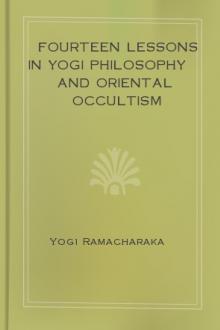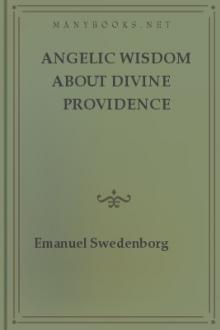A Series of Lessons in Gnani Yoga by William Walker Atkinson (best ereader for pc .txt) 📕

- Author: William Walker Atkinson
- Performer: 1428013288
Book online «A Series of Lessons in Gnani Yoga by William Walker Atkinson (best ereader for pc .txt) 📕». Author William Walker Atkinson
And this is a faint idea of what we believe the Absolute to be. In the following lessons we shall see it in operation in all forms of life, and in ourselves. We shall get close to the workings of Its mighty Will—close to Its Heart of Love.
Carry with you the Central Thought of the Lesson: CENTRAL THOUGHT. There is but One Life in the Universe. And underlying that One Life—Its Real Self—Its Essence—Its Spirit—is The Absolute, living, feeling, suffering, rejoicing, longing, striving, in and through us. The Absolute is all that really Is, and all the visible Universe and forms of Life is Its expression, through Its Will. We lack words adequate to describe the nature of the Absolute, but we will use two words describing its inmost nature as best we see it. These two words are LIFE and LOVE, the one describing the outer, the other the inner nature. Let us manifest both Life and Love as a token of our origin and inner nature. Peace be with you.
THE SECOND LESSON OMNIPRESENT LIFE.In our First Lesson of this series, we brought out the idea that the human mind was compelled to report the fact that it could not think of The Absolute except as possessing the quality of Omnipresence—Present-Everywhere. And, likewise, the human mind is compelled to think that all there IS must be The Absolute, or of the Absolute. And if a thing is of the Absolute, then the Absolute must be in it, in some way—must be the essence of it. Granting this, we must then think that everything must be filled with the essence of Life, for Life must be one of the qualities of the Absolute, or rather what we call Life must be the outward expression of the essential Being of the Absolute. And if this be so, then it would follow that everything in the Universe must be Alive. The mind cannot escape this conclusion. And if the facts do not bear out this conclusion then we must be forced to admit that the entire basic theory of the Absolute and its emanations must fall, and be considered as an error. No chain is stronger than its weakest link, and if this link be too weak to bear the weight of the facts of the universe, then must the chain be discarded as imperfect and useless, and another substituted. This fact is not generally mentioned by those speaking and writing of All being One, or an emanation of the One, but it must be considered and met. If there is a single thing in the Universe that is "dead"—non-living—lifeless—then the theory must fall. If a thing is non-living, then the essence of the Absolute cannot be in it—it must be alien and foreign to the Absolute, and in that case the Absolute cannot be Absolute for there is something outside of itself. And so it becomes of the greatest importance to examine into the evidences of the presence of Life in all things, organic or inorganic. The evidence is at hand—let us examine it.
The ancient occultists of all peoples always taught that the Universe was Alive—that there was Life in everything—that there was nothing dead in Nature—that Death meant simply a change in form in the material of the dead bodies. They taught that Life, in varying degrees of manifestation and expression, was present in everything and object, even down to the hardest mineral form, and the atoms composing that form.
Modern Science is now rapidly advancing to the same position, and each months investigations and discoveries serve only to emphasize the teachings.
Burbank, that wonderful moulder of plant life, has well expressed this thought, when he says: "All my investigations have led me away from the idea of a dead material universe tossed about by various forces, to that of a universe which is absolutely all force, life, soul, thought, or whatever name we may choose to call it. Every atom, molecule, plant, animal or planet, is only an aggregation of organized unit forces, held in place by stronger forces, thus holding them for a time latent, though teeming with inconceivable power. All life on our planet is, so to speak, just on the outer fringe of this infinite ocean of force. The universe is not half dead, but all alive."
Science today is gazing upon a living universe. She has not yet realized the full significance of what she has discovered, and her hands are raised as if to shade her eyes from the unaccustomed glare that is bursting upon her. From the dark cavern of universal dead matter, she has stepped out into the glare of the noon-day sun of a Universe All-Alive even to its smallest and apparently most inert particle.
Beginning at Man, the highest form of Life known to us, we may pass rapidly down the scale of animal life, seeing life in full operation at each descending step. Passing from the animal to the vegetable kingdom, we still see Life in full operation, although in lessened degrees of expression. We shall not stop here to review the many manifestations of Life among the forms of plant-life, for we shall have occasion to mention them in our next lesson, but it must be apparent to all that Life is constantly manifesting in the sprouting of seeds; the putting forth of stalk, leaves, blossoms, fruit, etc., and in the enormous manifestation of force and energy in such growth and development. One may see the life force in the plant pressing forth for expression and manifestation, from the first sprouting of the seed, until the last vital action on the part of the mature plant or tree.
Besides the vital action observable in the growth and development of plants, we know, of course, that plants sicken and die, and manifest all other attributes of living forms. There is no room for argument about the presence of life in the plant kingdom.
But there are other forms of life far below the scale of the plants. There is the world of the bacteria, microbes, infusoria—the groups of cells with a common life—the single cell creatures, down to the Monera, the creatures lower than the single cells—the Things of the slime of the ocean bed.
These tiny Things—living Things—present to the sight merely a tiny speck of jelly, without organs of any kind. And yet they exercise all the functions of life—movement, nutrition, reproduction, sensation, and dissolution. Some of these elementary forms are all stomach, that is they are all one organ capable of performing all the functions necessary for the life of the animal. The creature has no mouth, but when it wishes to devour an object it simply envelopes it—wraps itself around it like a bit of glue around a gnat, and then absorbs the substance of its prey through its whole body.
Scientists have turned some of these tiny creatures inside out, and yet they have gone on with their life functions undisturbed and untroubled. They have cut them up into still tinier bits, and yet each bit lived on as a separate animal, performing all of its functions undisturbed. They are all the same all over, and all the way through. They reproduce themselves by growing to a certain size, and then separating into two, and so on. The rapidity of the increase is most remarkable.
Haekel says of the Monera: "The Monera are the simplest permanent cytods. Their entire body consists of merely soft, structureless plasm. However thoroughly we may examine them with the help of the most delicate reagents and the strongest optical instruments, we yet find that all the parts are completely homogeneous. These Monera are therefore, in the strictest sense of the word, 'organisms without organs,' or even in a strict philosophical sense they might not even be called organisms, since they possess no organs and since they are not composed of various particles. They can only be called organisms in so far as they are capable of exercising the organic phenomena of life, of nutrition, reproduction, sensation and movement."
Verworn records an interesting instance of life and mind among the Rhizopods, a very low form of living thing. He relates that the Difflugia ampula, a creature occupying a tiny shell formed of minute particles of sand, has a long projection of its substance, like a feeler or tendril, with which it searches on the bottom of the sea for sandy material with which to build the shell or outer covering for its offspring, which are born by division from the parent body. It grasps the particle of sand by the feeler, and passes it into its body by enclosing it. Verworn removed the sand from the bottom of the tank, replacing it by very minute particles of highly colored glass. Shortly afterward he noticed a collection of these particles of glass in the body of the creature, and a little later he saw a tiny speck of protoplasm emitted from the parent by separation. At the same time he noticed that the bits of glass collected by the mother creature were passed out and placed around the body of the new creature, and cemented together by a substance secreted by the body of the parent, thus forming a shell and covering for the offspring. This proceeding showed the presence of a mental something sufficient to cause the creature to prepare a shell for the offspring previous to its birth—or rather to gather the material for such shell, to be afterward used; to distinguish the proper material; to mould it into shape, and cement it. The scientist reported that a creature always gathered just exactly enough sand for its purpose—never too little, and never an excess. And this in a creature that is little more than a tiny drop of glue!
We may consider the life actions of the Moneron a little further, for it is the lowest form of so-called "living matter"—the point at which living forms pass off into non-living forms (so-called). This tiny speck of glue—an organism without organs—is endowed with the faculty called sensation. It draws away from that which is likely to injure it, and toward that which it desires—all in response to an elementary sensation. It has the instinct of self-preservation and self-protection. It seeks and finds its prey, and then eats, digests and assimilates it. It is able to move about by "false-feet," or bits of its body which it pushes forth at will from any part of its substance. It reproduces itself, as we have seen, by separation and self-division.
The life of the bacteria and germs—the yeasty forms of life—are familiar to many of us. And yet there are forms of life still below these. The line between living forms and non-living forms is being set back further and further by science. Living creatures are now known that resemble the non-living so closely that the line cannot be definitely drawn.
Living creatures are known that are capable of being dried and laid away for several years, and then may be revived by the application of moisture. They resemble dust, but are full of life and function. Certain forms of bacilli are known to Science that have been subjected to degrees of heat and cold that are but terms to any but the scientific mind.
Low forms of life called Diatoms or "living crystals" are known. They are tiny geometrical forms. They are composed of a tiny drop of plasm, resembling glue, covered by a thin shell of siliceous or sandy material. They are visible only through the microscope, and are so small that thousands of them might be gathered together on the head of a pin. They are so like chemical crystals that it requires a shrewd and careful observer to distinguish them. And yet they are alive, and perform all the functions of life.
Leaving these creatures, we enter the kingdom of the crystals, in our search for life. Yes, the crystals manifest life, as strange as this statement may appear to those who have not followed the march of Science. The crystals are born, grow, live, and may be killed by chemicals or electricity. Science has added a new department called "Plasmology,"





Comments (0)